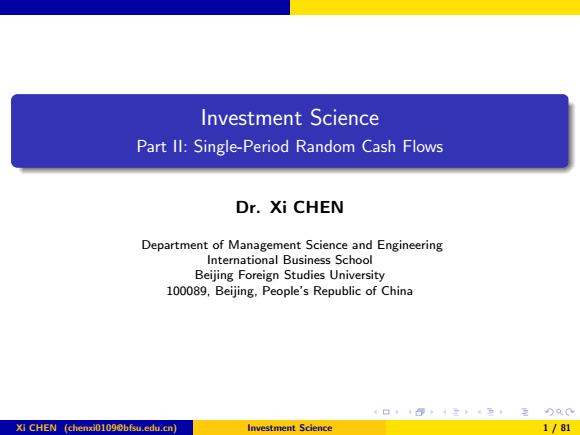
Investment Science Part Il:Single-Period Random Cash Flows Dr.Xi CHEN Department of Management Science and Engineering International Business School Beijing Foreign Studies University 100089,Beijing,People's Republic of China 4口,40+4立4至,三)及0 Xi CHEN (chenxi0109@bfsu.edu.cn) Investment Science 1/81
Investment Science Part II: Single-Period Random Cash Flows Dr. Xi CHEN Department of Management Science and Engineering International Business School Beijing Foreign Studies University 100089, Beijing, People’s Republic of China Xi CHEN (chenxi0109@bfsu.edu.cn) Investment Science 1 / 81
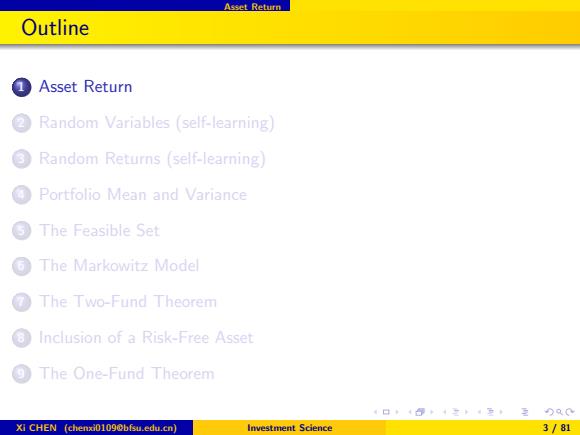
Asset Return Outline ①Asset Return Random Variables(self-learning) Random Returns (self-learning) Portfolio Mean and Variance The Feasible Set ⑥The Markowitz Model The Two-Fund Theorem Inclusion of a Risk-Free Asset The One-Fund Theorem 4口40+4三4至,至)只0 Xi CHEN (chenxi0109@bfsu.edu.cn) Investment Science 3/81
Asset Return Outline 1 Asset Return 2 Random Variables (self-learning) 3 Random Returns (self-learning) 4 Portfolio Mean and Variance 5 The Feasible Set 6 The Markowitz Model 7 The Two-Fund Theorem 8 Inclusion of a Risk-Free Asset 9 The One-Fund Theorem Xi CHEN (chenxi0109@bfsu.edu.cn) Investment Science 3 / 81
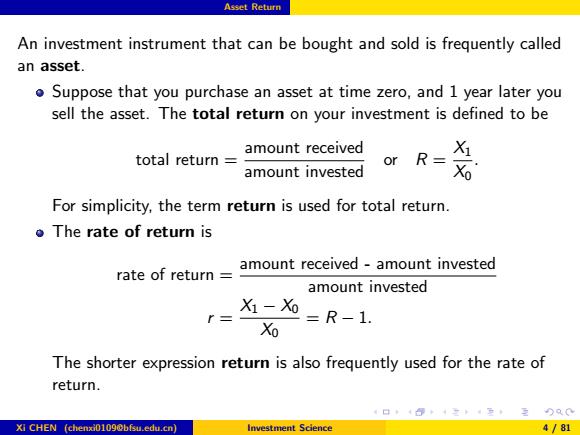
Asset Return An investment instrument that can be bought and sold is frequently called an asset. o Suppose that you purchase an asset at time zero,and 1 year later you sell the asset.The total return on your investment is defined to be amount received total return X amount invested or R=X For simplicity,the term return is used for total return. o The rate of return is rate of return amount received-amount invested amount invested I= X1-Xo Xo =R-1. The shorter expression return is also frequently used for the rate of return. )Q0 Xi CHEN (chenxi0109@bfsu.edu.cn) Investment Science 4/81
Asset Return An investment instrument that can be bought and sold is frequently called an asset. Suppose that you purchase an asset at time zero, and 1 year later you sell the asset. The total return on your investment is defined to be total return = amount received amount invested or R = X1 X0 . For simplicity, the term return is used for total return. The rate of return is rate of return = amount received - amount invested amount invested r = X1 − X0 X0 = R − 1. The shorter expression return is also frequently used for the rate of return. Xi CHEN (chenxi0109@bfsu.edu.cn) Investment Science 4 / 81
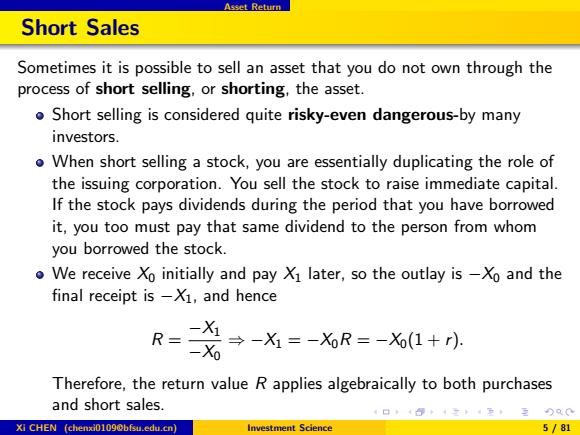
Asset Return Short Sales Sometimes it is possible to sell an asset that you do not own through the process of short selling,or shorting,the asset. o Short selling is considered quite risky-even dangerous-by many investors. o When short selling a stock,you are essentially duplicating the role of the issuing corporation.You sell the stock to raise immediate capital. If the stock pays dividends during the period that you have borrowed it,you too must pay that same dividend to the person from whom you borrowed the stock. o We receive Xo initially and pay X1 later,so the outlay is-Xo and the final receipt is-X1,and hence R=-X今-X=-X%R=-X(1+) -X0 Therefore,the return value R applies algebraically to both purchases and short sales. Xi CHEN (chenxi0109@bfsu.edu.cn) Investment Science 5/81
Asset Return Short Sales Sometimes it is possible to sell an asset that you do not own through the process of short selling, or shorting, the asset. Short selling is considered quite risky-even dangerous-by many investors. When short selling a stock, you are essentially duplicating the role of the issuing corporation. You sell the stock to raise immediate capital. If the stock pays dividends during the period that you have borrowed it, you too must pay that same dividend to the person from whom you borrowed the stock. We receive X0 initially and pay X1 later, so the outlay is −X0 and the final receipt is −X1, and hence R = −X1 −X0 ⇒ −X1 = −X0R = −X0(1 + r). Therefore, the return value R applies algebraically to both purchases and short sales. Xi CHEN (chenxi0109@bfsu.edu.cn) Investment Science 5 / 81
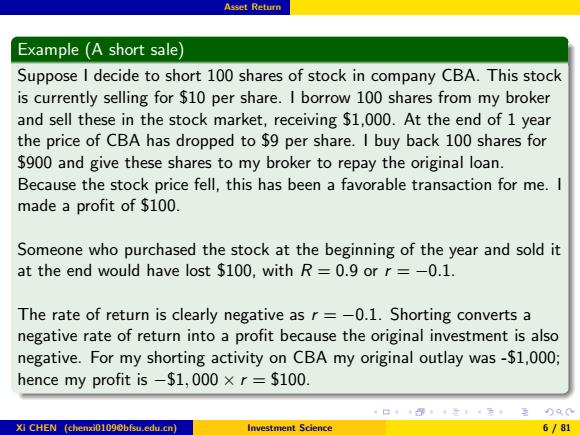
Asset Return Example (A short sale) Suppose I decide to short 100 shares of stock in company CBA.This stock is currently selling for $10 per share.I borrow 100 shares from my broker and sell these in the stock market,receiving $1,000.At the end of 1 year the price of CBA has dropped to $9 per share.I buy back 100 shares for $900 and give these shares to my broker to repay the original loan. Because the stock price fell,this has been a favorable transaction for me.I made a profit of $100. Someone who purchased the stock at the beginning of the year and sold it at the end would have lost $100,with R=0.9 or r=-0.1. The rate of return is clearly negative as r=-0.1.Shorting converts a negative rate of return into a profit because the original investment is also negative.For my shorting activity on CBA my original outlay was-51,000; hence my profit is-$1,000 x r=$100. Xi CHEN (chenxi0109@bfsu.edu.cn) Investment Science 6/81
Asset Return Example (A short sale) Suppose I decide to short 100 shares of stock in company CBA. This stock is currently selling for $10 per share. I borrow 100 shares from my broker and sell these in the stock market, receiving $1,000. At the end of 1 year the price of CBA has dropped to $9 per share. I buy back 100 shares for $900 and give these shares to my broker to repay the original loan. Because the stock price fell, this has been a favorable transaction for me. I made a profit of $100. Someone who purchased the stock at the beginning of the year and sold it at the end would have lost $100, with R = 0.9 or r = −0.1. The rate of return is clearly negative as r = −0.1. Shorting converts a negative rate of return into a profit because the original investment is also negative. For my shorting activity on CBA my original outlay was -$1,000; hence my profit is −$1, 000 × r = $100. Xi CHEN (chenxi0109@bfsu.edu.cn) Investment Science 6 / 81